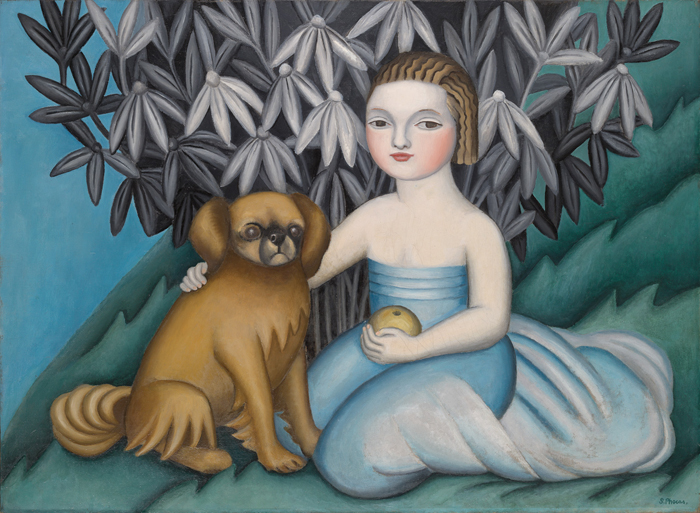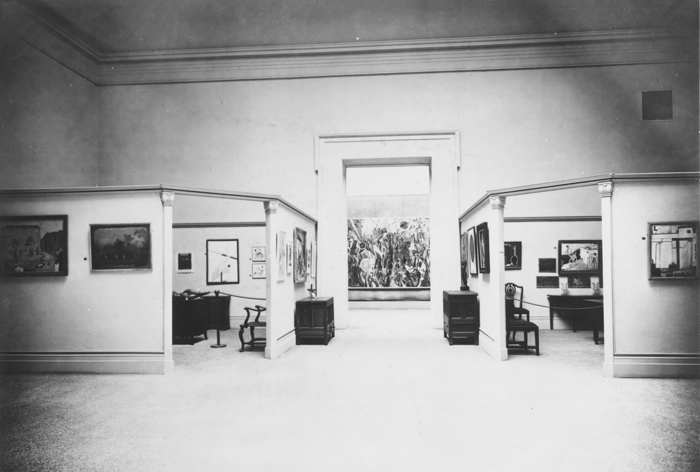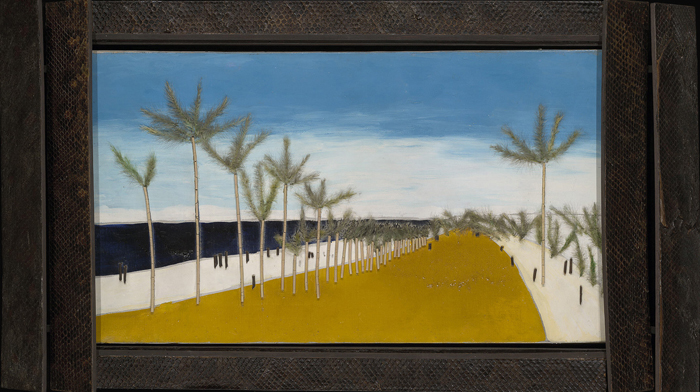
Suzanne Phocas, Child with Dog, 1925–26. Oil on canvas, painted directly on unprepared canvas, 29 7/8 x 39 3/8 in. Yale University Art Gallery. Gift of Collection Société Anonyme.
The Societe Anonyme, Inc., a prescient non-profit organization dedicated to promoting Modern Art and artists, was featured in a recent exhibition at the Hammer Museum. Founded in 1920 by artists Katherine Dreier, Marcel Duchamp and Man Ray, the Societe Anonyme was a nexus of support for contemporary artists. Established nine years before New York’s Museum of Modern Art, it organized group and solo exhibitions, supplemented on a regular basis by lectures, publications, concerts and dance performances selected to provide a context for the understanding of Modern art. Impressively, the Societe Anonyme also gathered a significant collection of painting, sculpture and other media in its thirty years of existence. Curators Jennifer Gross, Susan Greenberg and their colleagues organized this inspiring and informative exhibition about the Societe’s history and practices at the Yale University Art Gallery, the permanent location of the Collection Societe Anonyme and the show’s final venue.
The phrase “Societe Anonyme” is the French term for an unnamed or unincorporated business. Once legally incorporated in the United States, the name itself became a paradox–officially named and “unnamed” at once–a bit of word play not lost on the founding members. In order to support its endeavors, the Societe sold memberships and charged an admission fee to its gallery; it otherwise defined itself as “non-commercial,” referring interested buyers directly to the artist.1
Upon seeing the show at the Hammer, I left with two main responses. The first regards how this survey of Modern Art, formed from the perspective of artists of the time, shifted my perception of early 20th century art considerably. The second is that the Societe Anonyme offers a viable model for contemporary artists to consider when thinking about how to participate in the art world today.

International Exhibition of Modern Art, organized by Katherine S. Dreier and the Société Anonyme, Brooklyn Museum, November 1926–January 1927. Installation view. Katherine S. Dreier Papers/Société Anonyme Archive. Yale Collection of American Literature, Beinecke Rare Book and Manuscript Library.
The experimental nature of the Societe is revealed in many places throughout this show, but a compelling one occurs in one of the first galleries where a “reenactment” of the Societe’s inaugural exhibition is staged. This first show took place in 1920 in a suite of apartment-like rooms at 19 East 47th Street in New York City (where most of the founding members resided at the time). Duchamp designed the presentation of the exhibition. He vamped the walls with a cool blue oilskin, coated the floors in industrial gray ribbed rubber and, most unexpectedly, applied paper lace frames to all of the paintings in the show in a gesture of playful gallery cross-dressing. Sadly, in the Hammer’s large boxy gallery, the painted blue walls and ribbed flooring barely register. The lace frames, however, are as disruptive and humorous as they must have been at that first viewing.
Included in that first show were works by Constantine Brancusi, Man Ray, Duchamp and paintings by Vincent Van Gogh, Jacques Villon, Juan Gris and Morton Schaumberg, among others. In general, the group is a mixture of American and European artists whom the founding members of the Societe believed should be introduced to American audiences. Dreier, in particular, was most articulate and passionate about the Societe’s pedagogical dimension: “The Aim of the Societe Anonyme–Museum of Modern Art 1920–is educational. It is an International Organization for the promotion of the study in America of the Progressive in Art.”2
As a means of actively promoting Modern Art and the work of individual artists, the Societe Anonyme sponsored seventeen solo exhibitions over ten years. Some works by these artists are featured at the Hammer including a dozen paintings by Louis Michel Eilshemius, a lesser-known American poet-painter who was a favorite with the Societe. His murky, mysterious landscapes, seascapes and interiors are reminiscent of Albert Pinkham Ryder’s darker maritime landscapes, although they are more impressionistic than the latter’s work. Other artists whom the Societe supported with solo shows were Heinrich Campendoch, Paul Klee, Wassily Kandinsky and Fernand Leger. Yet another, Joseph Stella, was an active member of the Societe; his Brooklyn Bridge (1918-20) was in their inaugural show.
Although I’ve never been a fan of Stella’s paintings, I found myself drawn to Flower and Butterfly (c.1920-25), one of two drawings purchased by Dreier for her personal collection. This delicate work renders a slightly past-bloom pink tulip snaking up, like a third overgrown antenna, from the body of a fanned out brown and white butterfly. This work is the antithesis of the heroic Cubist-influenced cityscapes that I most associate with the artist. It is refreshing to encounter a philosophy of exhibition and collection, such as Dreier’s and the Societe Anonyme’s, that recognizes iconic works, but also embraces artworks that reflect the more eclectic or imperfect aspects of making art and, in turn, question culture’s impulse to construct a linear progression within the art-making process.

Joseph Stella, Flower and Butterfly, ca. 1920–25. Crayon and graphite on paper, 14 1/8 x 9 1/8 in. Yale University Art Gallery. Gift, Estate of Katherine S. Dreier.
It is apparent that Katherine Dreier was a driving force behind the activities of the Societe. A painter herself, Dreier hailed from a middle-to-upper-class German-American background. She was well educated, well traveled, and had studied in Europe and South America. Her concepts about art and painting were greatly influenced by the ideas of Wassily Kandinsky, who was her lifelong mentor and friend. Like Kandinsky, Dreier was a dedicated to Theosophy, a pantheistic belief system invested in intuitive knowledge and the spiritual unity of all things. For her, art was a significant means to attain and reflect this spiritual unity.3
Dreier, with feedback from Duchamp and other Societe members, curated a number of shows on behalf of the organization over the years. One of the largest and most significant was the International Exhibition of Modern Art at the Brooklyn Museum from November through December of 1926. Although other exhibitions of Modern Art had occurred in New York, such as the Armory Show of 1913 and the Society of Independent Artists Exhibition in 1917, the Brooklyn exhibition was unprecedented in its gathering of so many Modern American and European artworks in one place.
Many representative works from the International Exhibition are on view at the Hammer, including paintings and sculpture from a broad range of American, European, Russian and Scandinavian countries. In addition to painting, Dreier included photographs by Alfred Stieglitz and Man Ray, as well as wall-mounted wood assemblages by Jean Arp and Kurt Schwitters. She rounded out the show with a selection of Modern sculpture ranging from a more classical abstract bronze figure by Raymond Duchamp-Villon to Marcel Duchamp’s optical machine Rotary Glass Plates (Precision Optics) (1920) and Untitled (The Dancer) (1918-20) by John Storrs. This last object, also from Dreier’s personal collection, is a small ceramic piece whose dynamic shape gives the impression of a cross between some early Mayan relic and a chunk of petrified rock. There were a number of artists whose work I had never seen before: a Cubo-Futuristic painting by Finnur Jonsson, two luminescent gouaches by George Valmer of France, a stylized painting of a child and a dog by Valmer’s compatriot Suzanne Phocas, breathtaking movement studies by Austrian artist Erika Giovanna Klien, a freaky painting titled Eye of God (1923-25) by David Burliuk and others. In the original Brooklyn Museum presentation, works from different countries were intermixed in the galleries, but at the Hammer these works are organized according to the nationality of the artists. Because of this one loses a sense of the “level playing field” that Dreier established in the 1926 installation.
A highlight amongst all of these treasures is a work by Francis Picabia titled Midi (Promenade des anglais) (c. 1923-26), depicting a beachside avenue with two lines of palm trees converging at the horizon where yellow sand meets blue sky. In a move that would delight any devotee of kitsch, the painting is enhanced with dried pasta noodles (some kind of smooth ziti, I believe) that form the tree trunks and green caribou feathers for the palm fronds. The whole thing is then pushed “over the top” by a sizeable black snakeskin leather frame with window-like louvers made by artist and frame-maker Pierre Legrain. Overall, this work dances on the line between ridiculous and elegant.

Francis Picabia, Midi (Promenade des anglais), ca. 1923–26. Oil, feathers, macaroni, and leather on canvas in snakeskin frame (by Pierre Legrain), 21 3/4 x 39 1/4 in. Yale University Art Gallery. Gift of Collection Société Anonyme. © 2006 Artists Rights Society (ARS), New York/ADAGP, Paris.
It was Dreier’s philosophy that one should live with art in order for it to be appreciated and understood–intellectually and spiritually. To illustrate this ideal in the International Exhibition, Dreier created four rooms that were “intended to demonstrate ‘how Modern Art looks in the home.'”4 Outfitted with furniture from Abraham & Straus, a department store catering to middle and upper class Brooklynites, the rooms also featured a selection of handpicked figurative and abstract work by Modern artists. For Dreier, this concept of the integration of Modern Art and domestic space was essential to the continuing vitality of American society. “Unless we, as a nation, value art, we will not live. Unless we, as individuals, live with art, we cannot understand it.”5
This commitment to bringing Modern Art to America had yet another incarnation in the permanent collection of artworks that Dreier and Duchamp gradually gathered between the inception of the organization in 1920 and its dissolution in 1950. While the Societe Anonyme’s collection represents a good deal of work by (male) artists whose reputations have, for the most part, fared well for the past eighty plus years, what is most revealing about the overall holdings (as was the case with the International Exhibition of Modern Art), is the unexpected presence of minor or unusual works by artists we know, as well as works by lesser known artists. The collection included many women artists, along with artists from Russia, Scandinavia and Europe. This variety of works recontextualizes those of the “masters” through their inclusion in the collection and presents a richer picture of the context within which art was made at the time than I have previously encountered.
It is impossible to list here all of the artworks on view at the Hammer that are a part of the Collection Societe Anonyme. They range from John Covert’s and Marthe Donas’s earthy, mixed media explorations of composition and rhythm to the iconic simplicity of Brancusi’s Yellow Bird (1919) and Sofi Taeuber Arp’s Turned Wood Sculpture (1937). Stefi Kiesler’s refined “Typo-Plastic” drawings made on a typewriter pose an innovative meditation on the relationship between man (or in this case woman) and machine–a pervasive subject in art at the time. Although many individual works were memorable, one is mainly left with an appreciation for the evident interaction between numerous artists and art practices.
In her introduction to the exhibition’s catalogue, Jennifer Gross discusses how the significant work of the Societe provided a network of communication and support for Modern artists within the US and abroad.6 This network is eloquently invoked in the Hammer exhibition by a selection of letters from Dreier’s archive. These letters from El Lissitsky, Paul Klee, Suzanne Duchamp (Duchamp’s sister), Kurt Schwitters, Joseph Stella and others, testify to the very real exchange of intellectual encouragement and practical support that these artist’s shared with one another, particularly given the hardships suffered by so many artists working in Europe in the era of WWII.

Katherine S. Dreier and Marcel Duchamp in the library at The Haven, her estate in West Redding, CT, 1936. Above the bookshelf is Tu m’, installed in 1931. Katherine S. Dreier Papers/Société Anonyme Archive. Yale Collection of American Literature, Beinecke Rare Book and Manuscript Library.
A key component of that network of communication and support was the unique relationship between Katherine Dreier and Marcel Duchamp, an exchange that is centrally featured at this exhibition.7 A great admirer of Duchamp’s work, Dreier acquired several of his significant artworks, including his Large Glass (1915-23), which resided in her library, along with Tu m’ (1918), a work considered to be a summation of his work at that point and a farewell to painting. Beyond her support for his work, they were fellow artists and their affiliation in the affairs of the Societe is best described as collaborative. In a quintessential “odd couple” partnership, Dreier’s conviction and optimism were a foil to Duchamp’s ambivalence toward the art world (or, at times, his downright pessimism). Many years Duchamp’s senior, Dreier positioned herself as a matronly figure in relation to his younger, bon vivant persona in the social and cultural circles of New York and Europe. Over the years, she hosted innumerable Societe Anonyme events, but Duchamp was her sounding board in developing most of these projects. In her later years, when her health declined, his concern for her wellbeing is documented touchingly in letters and in photographs. Duchamp further demonstrated his respect for her life’s passion by working tirelessly, both while Dreier was still alive and as an executor of her estate, to place her personal art collection and that of the Societe in good hands.8 The way their relationship is revealed in the show at the Hammer was quite moving because it is in such stark contrast to how Duchamp has been mythologized as an isolated cerebral figure, pulling post-modernist gestures out of thin air.

Katherine Dreier, Explosion, 1940-47. Oil on canvas. Yale University Art Gallery, Gift of Collection Société Anonyme.
By the time one reaches the last room at the Hammer, one is deeply aware of the complex visual dialogue that is reflected in the Societe Anonyme collection. Concepts and imagery ricochet between Post-Impressionists and early American Abstract painters, from Russian Constructivists to Futurists and Cubists, from decorative to graphic arts, and from music to dance and back again to painting. Explorations of mixed media, photography and newly minted industrial materials intersect with examinations of architecture and machines. These connections extend in every direction, refracting among the artworks. But what underlies that visual dialogue is a network of relationships, of personal and intellectual exchanges that generated a context within which art mattered. Today, when so much of art’s value is over-determined by large museums with vast resources, narrow agendas and hardcore marketing strategies, the dialogue of meaning generated by artworks seems to get lost in all of that jockeying for attention. The corollaries in this matrix are the biennials, art fairs, commercial galleries, glossy art magazines, high profile grad schools and the branding of artists and exhibitions. More often than not, this framework divides individual artists from one another. The founders of the Societe Anonyme had the foresight to jump into the fray with their own interpretation of an institution–an artist’s museum that would prioritize discourse as its “raison d’etre.” The ambition of these artists was to define themselves (and one another) historically, rather than be passive entities in the definitions of critics and art historians. Wielding the tools of galleries, collections and museums, these artists, as a sort of proto collective, exerted a kind of control artists can well learn from today.
Jennifer Gross and Susan Greenberg have arranged an exhibition that does justice to the ambition and the spirit of Dreier, Duchamp and the many other members who championed the cause of the Societe Anonyme over the years. As Dreier did in her exhibitions and programs, Gross generously presents this rich body of work in a way that gives equal footing to the viewer and to the artworks in the hopes of generating a meaningful encounter. Old friends Dreier and Duchamp would surely be pleased to know that we are being encouraged to delve into and learn from the vibrant archive of thought and practice that is their bequest.
Karen Dunbar is an artist and educator who lives in Los Angeles.
